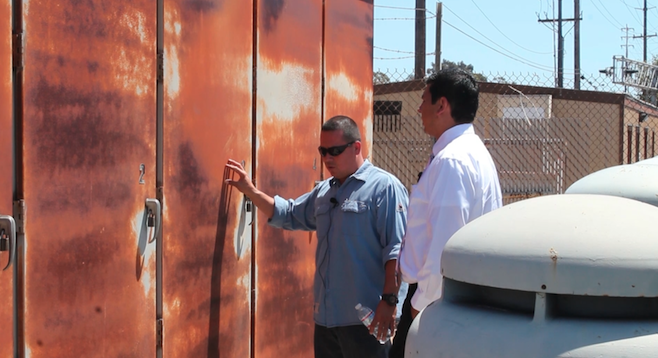 Facebook
Facebook
 X
X
 Instagram
Instagram
 TikTok
TikTok
 Youtube
Youtube

Daniel Orozco's job is maintaining the city's 15 storm-water pump stations. He recently testified before the city council's Environment Committee, saying that about two years ago, he determined a method for being notified if a pump system's power fails.
"I strategized and installed strobe lights and when the system fails they go on," he explained. "I gave my card to the transients [who shelter near the pumping stations] and they call me when they see the light go on.”
Orozco declined to identify all the pumping stations where he made this arrangement (his union rep also did not return phone calls). He did say a group of four homeless people who camp near the Rosecrans/Pacific Highway location have his card. So far, due in large part to a dry winter, his makeshift alarm system hasn’t been necessary. But that doesn’t mean the city’s pump stations don’t need attention.
At the beginning of September, Orozco took San Diego city councilman David Alvarez on a tour of the pump station at Rosecrans and Pacific Highway, next to the I-5. The station has pipes that have failed, rusted electrical cabinets, and no alarm system to warn of break-ins — usually for copper pipe.
The pump stations for Mission Beach and Sorrento Valley are for emergencies, when rain overwhelms the storm-water drain system and flooding is imminent. Only one of the 15 pump stations has a back-up generator, Orozco said. A video of the tour was played at the city council's Environment Committee meeting.
Although meeting observers delighted in Orozco's enterprising solution of recruiting the homeless to provide security, councilmembers Lori Zapf and Ed Harris expressed concern over flooding. Harris a former lifeguard, said he recalls the dangers of flood rescues.
Alvarez said, “I was disturbed to see how in disrepair the pump station was — it made me realize how in danger we are should we have a serious flooding event in San Diego.” He described "really outdated technology and dangerously deteriorating conditions.”
Beyond flooding, problems with storm-water control can also be expensive because of the rigorous enforcement actions of the state Regional Water Quality Control Board. For example, in August, the city agreed to a $950,000 fine for other, unrelated storm-water control violations, including failing to use the best possible run-off controls. The city also agreed to perform $1.6 million worth of storm-water control improvements on public projects, according to water-quality board environmental scientist Christopher Means.
A consultant report had recommended each of the 15 pump stations get a telemetry system for about $50,000 each to warn of pump or power failures. But the city's budget problems have led to chronic underfunding of infrastructure and the Storm Water Division is no exception.


Daniel Orozco's job is maintaining the city's 15 storm-water pump stations. He recently testified before the city council's Environment Committee, saying that about two years ago, he determined a method for being notified if a pump system's power fails.
"I strategized and installed strobe lights and when the system fails they go on," he explained. "I gave my card to the transients [who shelter near the pumping stations] and they call me when they see the light go on.”
Orozco declined to identify all the pumping stations where he made this arrangement (his union rep also did not return phone calls). He did say a group of four homeless people who camp near the Rosecrans/Pacific Highway location have his card. So far, due in large part to a dry winter, his makeshift alarm system hasn’t been necessary. But that doesn’t mean the city’s pump stations don’t need attention.
At the beginning of September, Orozco took San Diego city councilman David Alvarez on a tour of the pump station at Rosecrans and Pacific Highway, next to the I-5. The station has pipes that have failed, rusted electrical cabinets, and no alarm system to warn of break-ins — usually for copper pipe.
The pump stations for Mission Beach and Sorrento Valley are for emergencies, when rain overwhelms the storm-water drain system and flooding is imminent. Only one of the 15 pump stations has a back-up generator, Orozco said. A video of the tour was played at the city council's Environment Committee meeting.
Although meeting observers delighted in Orozco's enterprising solution of recruiting the homeless to provide security, councilmembers Lori Zapf and Ed Harris expressed concern over flooding. Harris a former lifeguard, said he recalls the dangers of flood rescues.
Alvarez said, “I was disturbed to see how in disrepair the pump station was — it made me realize how in danger we are should we have a serious flooding event in San Diego.” He described "really outdated technology and dangerously deteriorating conditions.”
Beyond flooding, problems with storm-water control can also be expensive because of the rigorous enforcement actions of the state Regional Water Quality Control Board. For example, in August, the city agreed to a $950,000 fine for other, unrelated storm-water control violations, including failing to use the best possible run-off controls. The city also agreed to perform $1.6 million worth of storm-water control improvements on public projects, according to water-quality board environmental scientist Christopher Means.
A consultant report had recommended each of the 15 pump stations get a telemetry system for about $50,000 each to warn of pump or power failures. But the city's budget problems have led to chronic underfunding of infrastructure and the Storm Water Division is no exception.
Comments